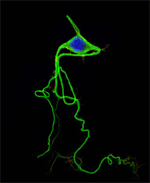The slow road to a synapse
By By Scott LaFee | 12 May 2011
Grappling with a question that has defied scientific explanation for decades, a small team of researchers from the University of California, San Diego School of Medicine offers the first evidence-based model to explain how certain proteins in neurons travel from the central body of the cell (where they are made) down its axon to the terminal synapse – the junction where neurons communicate with each other.
 |
| Human neuron, stained. |
The research, led by Subhojit Roy, MD, PhD, a cell biologist and neuropathologist in the department of neurosciences at UC San Diego School of Medicine and the Shiley-Marcos Alzheimer's Disease Research Center, appears in the May 12 issue of the journal Neuron.
To function and survive, the central bodies of neurons operate like tiny factories, constantly manufacturing proteins that are shipped via the cell's long, thin axon to distant synapses.
''It can be quite a journey,'' said Roy. ''Axons may be 10,000 times longer than the neuron's body is wide. Typically, they have thousands of times more volume. If you imagine my office as the cell-body, the axon would end in San Francisco. So the cell has to constantly ship things back and forth over comparatively enormous distances.''
Some proteins make this journey via ''fast axonal transport.'' They ride in motor-driven intracellular sacs called vesicles that speed to the synapses like an express train. But hundreds of other ''cytosolic'' proteins that do not anchor to vesicles take much longer to make the trip, and until now, no one has had a plausible explanation of how these soluble cargoes undertake ''slow axonal transport.''
In the 1970s, using pulse-chase radiolabeling, scientists discovered that cytosolic proteins (so-called because they reside in the cell's liquid medium, the cytosol) moved toward and through the axon in a directed, wave-like motion. Though this ruled out a passive diffusive process, scientists could not find a mechanistic explanation for the curious, slow, coordinated movement of proteins.






























